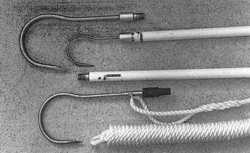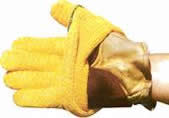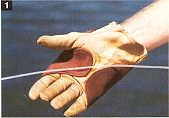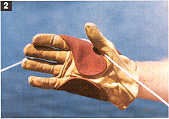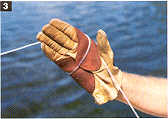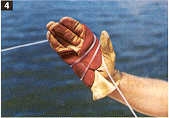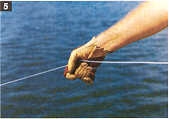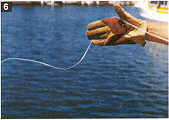07: Tagging and Gaffing
by Peter Pakula
|
For the purpose of this article we are assuming that we only have two men on board a relatively small boat, say a sub eight metre craft. Everything becomes much simpler with a third set of hands in the cockpit to handle the gaff or tag chores. When we concluded the last article "Boat Handling and Tactics" we had the boat downwind of the fish and the boat running close, and parallel to the fish. The skipper had eased back to have the fish alongside the steering position, then brought the boat over so he could leave the wheel and take the trace. To begin this part of the exercise, we need to take a few steps back to the beginning of the fight. GET THE COCKPIT READYEarly in the fight, when the fish has powered away after the strike, the boat may be left idling forward, or out of gear if the wind is strong enough, as long as the boat is moving away from the fish. At this point the skipper has to leave the wheel and clear the other rods. If there is no wind, he is going to have to get into some fancy footwork between wheel and cockpit to keep the boat idling away from the fish. Certainly hydraulic steering and autopilots make this much easier. When lures with razor sharp hooks are retrieved they must be removed from the cockpit or stored somewhere right out of the way. Securing lures does not include sticking a hook through a guide frame, winding trace around a reel or anything else of that nature. It means getting it right out of the way. As each lure is retrieved then, the trace should be un-snapped and the lure and trace either put in the cabin or in some other enclosed storage space. The rods are left in the holders for the moment. With all the lures secured, the rods are then removed and located right out of the way. This definitely does not mean having them leaning on the gunwales. Put them in a cabin or up in a rocket launcher. If you store gaffs in side pockets or side racks, it is ideal to have gaffs either side of the cockpit. If you only have a single set of gaffs, wait until you get towards the end of the fight, and depending on the way the boat is facing at that point, locate the gaff you want on the upwind side of the cockpit. A handy spot to locate a short handled gaff is to hang it over the back of the helm or passenger seat. This keeps it close handy and the point of the hook right out of the way. TRACE & GAFFNow we come back to the point where the skipper has left the wheel and has donned gloves. He takes the quick release double wrap (shown at bottom of article) and holds the fish in place or simply grab the leader in the gloved hand and pinch the leader with the thumb and lift hand over hand. Now you see the advantage of the angler wearing a harness. If he is, he backs the drag off about one quarter, just leaving enough drag on to avoid an overrun if the fish bolts, and takes over the gaff duties with the rod still attached to him by gimbal belt and harness. A point to note is if the fish is being caught under IGFA rules for points, tourney or record, is that if you put the rod in a rod holder to do the gaffing or tagging the fish is then an illegal capture, plus in case the fish bolts and has to be played back to the boat again. If, on the other hand, you are tagging the fish then as soon as the tag is placed, the tag is considered to be legal. So the harness allows the angler to take part in the gaffing/tagging, and he is ready to roll if the fish breaks away. If the angler is not wearing a harness, the nature and duration of the fight become very important. The last thing you want is a wild, green fish at the side of the boat. This can happen when a macho angler using heavy tackle for the size of fish drags it to boat side prematurely, or when too much boat has been used to get alongside the fish when he is still hot. Generally speaking, fish that have been played out under decent pressure for some time will be relatively docile at the side of the boat, with the exception of sharks. Most sharks seem to save their best for last, and rolling tactics are not only difficult to deal with, they can also do a lot of damage to the boat. For the boat where the angler is not in harness then, two alternatives are available to keep the capture or tagging legal. The first is that the skipper can handle both the trace and gaff, and the second is that the angler takes a one handed gaff shot, which is relatively simple with anything other than a very large fish or shark. If the understanding is that the angler will place the gaff, the skipper should have a second gaff handy to go straight to as soon as the first gaff is in place. The idea being that he can quickly take the pressure off the angler who can then get rid of the rod and help boat the fish. When a flying gaff is to be used, THE ART OF THE GAFFYou can substitute tag for the word gaff here, depending on the situation. First, be aware I of an element of danger in all of I this. That element of danger increases or decreases according the relationship of the fish to the boat. Given a small enough boat, and a big enough fish, there is a very real possibility for disaster. Boats have had serious damage done when big fish have been tied off on badly fitted undersized cleats and bollards. Other boats have had sterns dragged right under when big sharks have been stuck with a flying gaff secured to an aft cleat. It is also well worth noting that many serious accidents occur when a wild fish is brought inboard with lure and hooks being swung all over the place in the struggle. Being pinned with a large stainless game hook is a serious business and something to be avoided at all costs especially if using two hooks rigs and one of is still in the fish. If you want to be good with the gaff, remember this; the art of good gaffing is to learn that gaffs are placed, not swung at the target. You line the point of the gaff up exactly where you want it to go, close to the mark, then you pull it into the fish, using the fish's weight to set the hook. Never lunge at fish with a gaff, or stick the gaff under water and try to chase the fish around with it. If you The very best place to go for your gaff shot is in the shoulder of the fish or in the case of a tag just below the dorsal, as this allows a large open area of target, the bulkiest part of the fish to offer resistance to the hook, and the bone structure running right down the fish's back under the dorsel fins also helps hold the gaff in place. In the case of smaller fish for the table a head shot with the gaff will save damaging the flesh. Allowing for the fact that you are going to rely on the bulk and resistance of the fish to sink the point of the gaff, it is important to keep the size of the gaff in keeping with the size of the fish. If you use too big a gaff, the diameter of the hook will require considerable resistance in the target to be successfully driven home, and you will probably just move a light fish sideways through the water. If you want a rule of thumb, a gaff with a hook gape that is roughly around a third the depth of the fish would be fairly ideal. A 10cm gaff, for example, would be about right for fish from say 15kg to 30kg. Looking at this selection of gaff heads, it is obvious that it will take a whole lot more effort to drive in the point of the largest flyer than it will to sink the smallest hook. Only use big gaffs when you really need them. Flying gaffs are not required on billfish under around 90kg, yellowfin don't really require flying gaffs at all, though you'd better be ready to hang on! and nearly all sharks are best handled with a flying gaff due to their habit of rolling once gaffed. Think carefully before tying a fling gaff off on your cleat and sinking the hook into a big shark. If weight and power goes in favour of the shark, he can very easily get a stern quarter under the water, and at that point the ocean rushing in will continue to tip the odds in his favour. You could find yourself on the losing end of the struggle in a big way. Going back to that trace, it makes very little sense to skilfully play a fish on a carefully set drag for a couple of hours, then have Rambo grab the trace, dig in and lock up. All manner of things could have happened to your terminal gear during the fight, and the hook might be just sitting in a big hole worn around the point of entry. When Rambo locks up, for the first time in the encounter your terminal gear will be over-worked, and with a quick, powerful jerk against a fixed point, seemingly unbreakable gear will come apart like cotton. The trace is there to lead the fish, not to be used to overpower it. If it can't be controlled with reasonable pressure, let it go on swimming for awhile.
FROM: POWERBOAT FISHING January/February 1994 |
||||||||||||






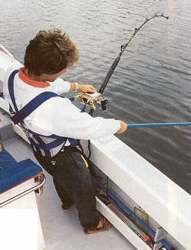
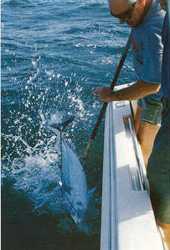 can't place the gaff where you want it, you are not ready to gaff the fish. The same thing goes for tagging.
can't place the gaff where you want it, you are not ready to gaff the fish. The same thing goes for tagging.